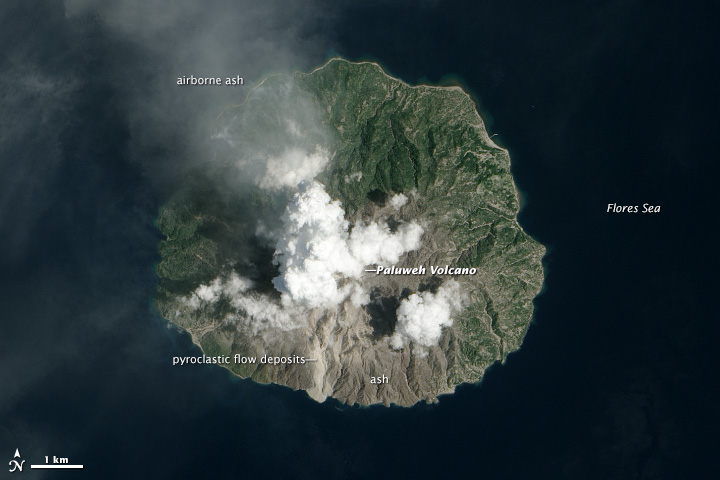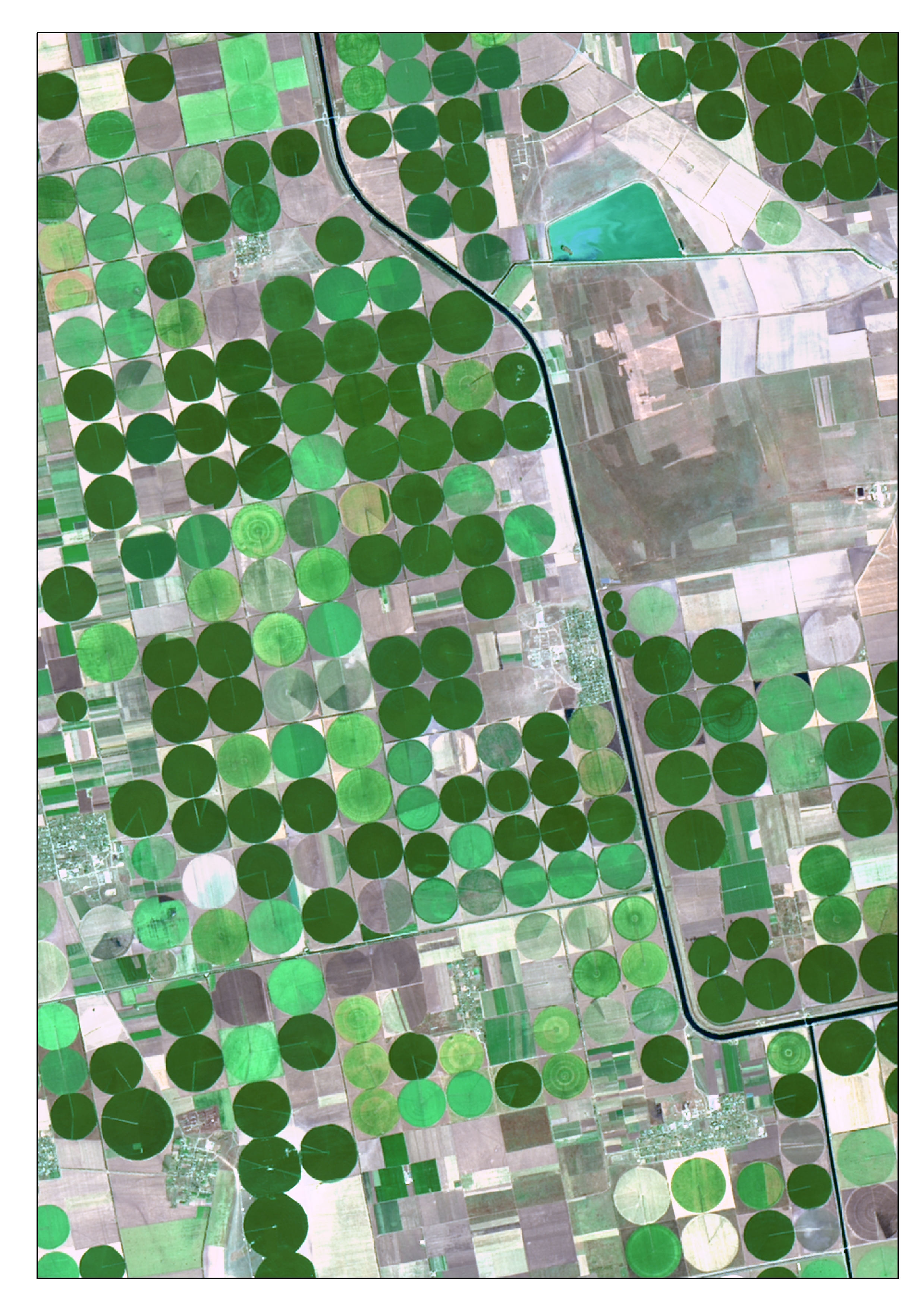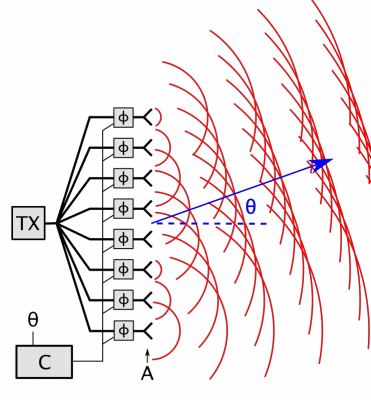|
EO-1
Earth Observing-1 (EO-1) is a decommissioned NASA Earth observation satellite created to develop and validate a number of instrument and spacecraft bus breakthrough technologies. It was intended to enable the development of future Earth imaging observatories that will have a significant increase in performance while also having reduced cost and mass. The spacecraft was part of the New Millennium Program. It was the first satellite to map active lava flows from space; the first to measure a facility's methane leak from space; and the first to track re-growth in a partially logged Amazon forest from space. EO-1 captured scenes such as the ash after the World Trade Center attacks, the flooding in New Orleans after Hurricane Katrina, volcanic eruptions and a large methane leak in southern California. Overview Its Advanced Land Imager (ALI) measured nine different wavelengths simultaneously, instead of the seven measured by the imager in Landsat 7. This permitted a greater flexibili ... [...More Info...] [...Related Items...] OR: [Wikipedia] [Google] [Baidu] |
Landsat 7
Landsat 7 is the seventh satellite of the Landsat program. Launched on 15 April 1999, Landsat 7's primary goal is to refresh the global archive of satellite photos, providing up-to-date and cloud-free images. The Landsat program is managed and operated by the United States Geological Survey, and data from Landsat 7 is collected and distributed by the USGS. The NASA WorldWind project allows 3D images from Landsat 7 and other sources to be freely navigated and viewed from any angle. The satellite's companion, Earth Observing-1, trailed by one minute and followed the same orbital characteristics, but in 2011 its fuel was depleted and EO-1's orbit began to degrade. Landsat 7 was built by Lockheed Martin Space Systems. In 2016, NASA announced plans to attempt the first ever refueling of a live satellite by refueling Landsat 7 in 2020 with the OSAM-1 mission; as of 2021, the launch date has slipped to 2025. NASA plans to decommission the satellite following the 2021 launch and ac ... [...More Info...] [...Related Items...] OR: [Wikipedia] [Google] [Baidu] |
Hyperspectral Imager
Hyperspectral imaging collects and processes information from across the electromagnetic spectrum. The goal of hyperspectral imaging is to obtain the spectrum for each pixel in the image of a scene, with the purpose of finding objects, identifying materials, or detecting processes. There are three general branches of spectral imagers. There are push broom scanners and the related whisk broom scanners (spatial scanning), which read images over time, band sequential scanners (spectral scanning), which acquire images of an area at different wavelengths, and snapshot hyperspectral imaging, which uses a staring array to generate an image in an instant. Whereas the human eye sees color of visible light in mostly three bands (long wavelengths - perceived as red, medium wavelengths - perceived as green, and short wavelengths - perceived as blue), spectral imaging divides the spectrum into many more bands. This technique of dividing images into bands can be extended beyond the visible. ... [...More Info...] [...Related Items...] OR: [Wikipedia] [Google] [Baidu] |
New Millennium Program
New Millennium Program (NMP) was a NASA project with focus on engineering validation of new technologies for space applications. Funding for the program was eliminated from the FY2009 budget by the 110th United States Congress, effectively leading to its cancellation. The spacecraft in the New Millennium Program were originally named "Deep Space" (for missions demonstrating technology for planetary missions) and "Earth Observing" (for missions demonstrating technology for Earth orbiting missions). With a refocussing of the program in 2000, the Deep Space series was renamed "Space Technology". NMP missions Missions flown *Deep Space 1 – standalone spacecraft testing solar electric propulsion, autonomous operation etc.; successful mission 1998-2001 including comet and asteroid encounters * Deep Space 2 – Mars surface penetrators flown with Mars Polar Lander in 1999; (failed) *Earth Observing 1 (EO-1) – (launched 2000) *Space Technology 5 – a cluster of three satellites i ... [...More Info...] [...Related Items...] OR: [Wikipedia] [Google] [Baidu] |
Landsat 8
Landsat 8 is an American Earth observation satellite launched on 11 February 2013. It is the eighth satellite in the Landsat program; the seventh to reach orbit successfully. Originally called the Landsat Data Continuity Mission (LDCM), it is a collaboration between NASA and the United States Geological Survey (USGS). NASA Goddard Space Flight Center in Greenbelt, Maryland, provided development, mission systems engineering, and acquisition of the launch vehicle while the USGS provided for development of the ground systems and will conduct on-going mission operations. It comprises the camera of the Operational Land Imager (OLI) and the Thermal Infrared Sensor (TIRS), which can be used to study Earth surface temperature and is used to study global warming. The satellite was built by Orbital Sciences Corporation, who served as prime contractor for the mission. The spacecraft's instruments were constructed by Ball Aerospace & Technologies and NASA's Goddard Space Flight Center (GS ... [...More Info...] [...Related Items...] OR: [Wikipedia] [Google] [Baidu] |
NASA
The National Aeronautics and Space Administration (NASA ) is an independent agency of the US federal government responsible for the civil space program, aeronautics research, and space research. NASA was established in 1958, succeeding the National Advisory Committee for Aeronautics (NACA), to give the U.S. space development effort a distinctly civilian orientation, emphasizing peaceful applications in space science. NASA has since led most American space exploration, including Project Mercury, Project Gemini, the 1968-1972 Apollo Moon landing missions, the Skylab space station, and the Space Shuttle. NASA supports the International Space Station and oversees the development of the Orion spacecraft and the Space Launch System for the crewed lunar Artemis program, Commercial Crew spacecraft, and the planned Lunar Gateway space station. The agency is also responsible for the Launch Services Program, which provides oversight of launch operations and countdown m ... [...More Info...] [...Related Items...] OR: [Wikipedia] [Google] [Baidu] |
Teflon
Polytetrafluoroethylene (PTFE) is a synthetic fluoropolymer of tetrafluoroethylene that has numerous applications. It is one of the best-known and widely applied PFAS. The commonly known brand name of PTFE-based composition is Teflon by Chemours, a spin-off from DuPont, which originally discovered the compound in 1938. Polytetrafluoroethylene is a fluorocarbon solid, as it is a high- molecular-weight polymer consisting wholly of carbon and fluorine. PTFE is hydrophobic: neither water nor water-containing substances wet PTFE, as fluorocarbons exhibit only small London dispersion forces due to the low electric polarizability of fluorine. PTFE has one of the lowest coefficients of friction of any solid. Polytetrafluoroethylene is used as a non-stick coating for pans and other cookware. It is non-reactive, partly because of the strength of carbon–fluorine bonds, so it is often used in containers and pipework for reactive and corrosive chemicals. Where used as a lubrican ... [...More Info...] [...Related Items...] OR: [Wikipedia] [Google] [Baidu] |
Pulsed Plasma Thruster
A pulsed plasma thruster (PPT), also known as a plasma jet engine, is a form of electric spacecraft propulsion. PPTs are generally considered the simplest form of electric spacecraft propulsion and were the first form of electric propulsion to be flown in space, having flown on two Soviet probes (Zond 2 and Zond 3) starting in 1964. PPTs are generally flown on spacecraft with a surplus of electricity from abundantly available solar energy. Operation Most PPTs use a solid material (normally PTFE, more commonly known as Teflon) for propellant, although very few use liquid or gaseous propellants. The first stage in PPT operation involves an arc of electricity passing through the fuel, causing ablation and sublimation of the fuel. The heat generated by this arc causes the resultant gas to turn into plasma, thereby creating a charged gas cloud. Due to the force of the ablation, the plasma is propelled at low speed between two charged plates (an anode and cathode). Since the plasma ... [...More Info...] [...Related Items...] OR: [Wikipedia] [Google] [Baidu] |
IBM RAD6000
The RAD6000 radiation-hardened single-board computer, based on the IBM RISC Single Chip CPU, was manufactured by IBM Federal Systems. IBM Federal Systems was sold to Loral, and by way of acquisition, ended up with Lockheed Martin and is currently a part of BAE Systems Electronic Systems. RAD6000 is mainly known as the onboard computer of numerous NASA spacecraft. History The radiation-hardening of the original RSC 1.1 million-transistor processor to make the RAD6000's CPU was done by IBM Federal Systems Division working with the Air Force Research Laboratory. , there are 200 RAD6000 processors in space on a variety of NASA, United States Department of Defense and commercial spacecraft, including: * Mars Exploration Rovers ( ''Spirit'' and ''Opportunity'') * Deep Space 1 probe * Mars Polar Lander and Mars Climate Orbiter * Mars Odyssey orbiter * Spitzer Infrared Telescope Facility * MESSENGER probe to Mercury * STEREO Spacecraft * IMAGE/Explorer 78 MIDEX spacecraft ... [...More Info...] [...Related Items...] OR: [Wikipedia] [Google] [Baidu] |
Imaging Spectrometer
An imaging spectrometer is an instrument used in hyperspectral imaging and imaging spectroscopy to acquire a spectrally-resolved image of an object or scene, often referred to as a datacube due to the three-dimensional representation of the data. Two axes of the image corresponds to vertical and horizontal distance and the third to wavelength. The principle of operation is the same as that of the simple spectrometer, but special care is taken to avoid optical aberrations for better image quality. Example imaging spectrometer types include: filtered camera, whiskbroom scanner, pushbroom scanner, integral field spectrograph (or related dimensional reformatting techniques), wedge imaging spectrometer, Fourier transform imaging spectrometer, computed tomography imaging spectrometer (CTIS), image replicating imaging spectrometer (IRIS), coded aperture snapshot spectral imager (CASSI), and image mapping spectrometer (IMS). Principle Imaging spectrometers are used specifically for th ... [...More Info...] [...Related Items...] OR: [Wikipedia] [Google] [Baidu] |
Optical Fiber Cable
A fiber-optic cable, also known as an optical-fiber cable, is an assembly similar to an electrical cable, but containing one or more optical fibers that are used to carry light. The optical fiber elements are typically individually coated with plastic layers and contained in a protective tube suitable for the environment where the cable is used. Different types of cable are used for different applications, for example, long distance telecommunication, or providing a high-speed data connection between different parts of a building. Design Optical fiber consists of a core and a cladding layer, selected for total internal reflection due to the difference in the refractive index between the two. In practical fibers, the cladding is usually coated with a layer of acrylate polymer or polyimide. This coating protects the fiber from damage but does not contribute to its optical waveguide properties. Individual coated fibers (or fibers formed into ribbons or bundles) then have a tou ... [...More Info...] [...Related Items...] OR: [Wikipedia] [Google] [Baidu] |
Smart Antenna
Smart antennas (also known as adaptive array antennas, digital antenna arrays, multiple antennas and, recently, MIMO) are antenna arrays with smart signal processing algorithms used to identify spatial signal signatures such as the direction of arrival (DOA) of the signal, and use them to calculate beamforming vectors which are used to track and locate the antenna beam on the mobile/target. Smart antennas should not be confused with reconfigurable antennas, which have similar capabilities but are single element antennas and not antenna arrays. Smart antenna techniques are used notably in acoustic signal processing, track and scan radar, radio astronomy and radio telescopes, and mostly in cellular systems like W-CDMA, UMTS, and LTE. Smart antennas have many functions: DOA estimation, beamforming, interference nulling, and constant modulus preservation.. Direction of arrival (DOA) estimation The smart antenna system estimates the direction of arrival of the signal, using techni ... [...More Info...] [...Related Items...] OR: [Wikipedia] [Google] [Baidu] |
Phased Array
In antenna theory, a phased array usually means an electronically scanned array, a computer-controlled array of antennas which creates a beam of radio waves that can be electronically steered to point in different directions without moving the antennas. In a simple array antenna, the radio frequency current from the transmitter is fed to multiple individual antenna elements with the proper phase relationship so that the radio waves from the separate elements combine ( superpose) to form beams, to increase power radiated in desired directions and suppress radiation in undesired directions. In a phased array, the power from the transmitter is fed to the radiating elements through devices called '' phase shifters'', controlled by a computer system, which can alter the phase or signal delay electronically, thus steering the beam of radio waves to a different direction. Since the size of an antenna array must extend many wavelengths to achieve the high gain needed for narrow ... [...More Info...] [...Related Items...] OR: [Wikipedia] [Google] [Baidu] |








